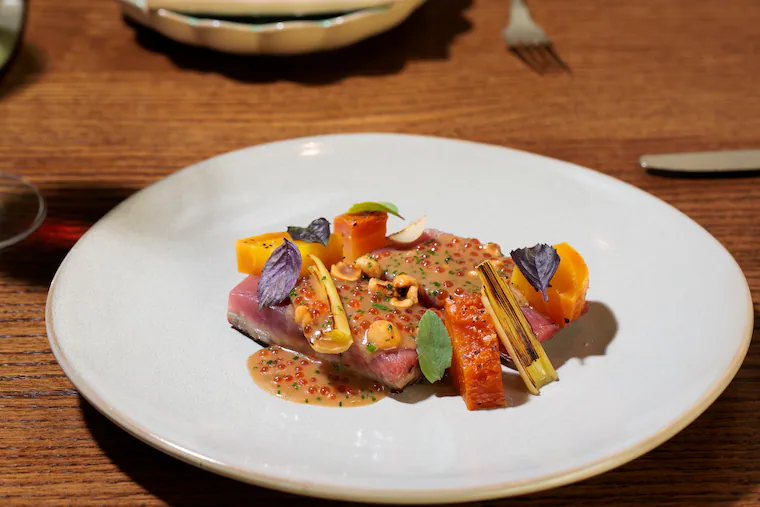
If all the world’s a stage, then chef Christopher Cryer is mounting the Kimmel Center’s most notable new production atop a block of seared tuna. At first glance, this showpiece entrée at Leo, the new restaurant at the performing arts center, is a striking plate of beauty, fish, and intrigue.
A lightly cooked square of yellowfin steak is sliced open through its rare pink middle to create a pedestal for the drama of garnishes to unfold: a warm and buttery flow of Madeira sauce jeweled with the briny pop of trout roe, the nutty snap of toasted hazelnuts, and skinny batons of roasted leeks offering delicate crunch. Colorful beet chunks linger near the tuna’s edges, too, but more as set props.
It’s a pretty pageant of layered colors, texture, and quality players, creatively assembled for subtle interplays. But it also features a clash of cool fish and warm sauce that makes it, as Cryer says, “an ambient dish.” In other words, deliberately lukewarm.
The result is pleasant enough to eat, but also so soft-spoken — despite the quantity of flourishes — that it’s not particularly memorable.
That lack of sizzle more or less sums up the way I felt about the entirety of my meals at Leo, which replaced Volvér this spring on the Spruce Street side of the Kimmel Center as part of Philadelphia Orchestra and Ensemble Arts Philly’s year-old affiliation with Rhubarb Hospitality Collection. Promising, but still acting as if it’s in preview mode.
The big question, as the curtain now rises on a new performance season, is whether or not “lukewarm” is good enough for the Kimmel Center to achieve sustainable success for its primary restaurant.
I’ve begun to wonder if it’s even possible for a restaurant there to be a draw on its own, and not just an amenity. That’s hard given the dynamic of Broad Street’s soulless corporate dining culture, not to mention the continued challenges for this specific setting, regardless of who’s cooking.
On the one hand, it’s a welcome fresh start for the space after a misfire with Volvér, a restaurant that stumbled from the beginning, despite grand ambitions and Jose Garces’ Iron Chef pedigree. It limped along for a decade through the operator’s bankruptcy and then a follow-up phase that leaned on guest-chef pop-ups while the menus and once-cushy furniture frayed.
The new space has the same built-in handicaps as the previous occupant, as it is essentially a fishbowl facing Spruce Street that’s physically divided from the Kimmel Center’s vaulted glass lobby, severing it from any performance-day energy and the potential to be a more integral part of the experience. Diners only experience that when they exit the restaurant into the lobby for a long trek to the common bathrooms downstairs, a design flaw right off the bat.
But I like the renovated room, which is lighter, brighter, and more inviting than Volvér, with jade green subway tiles, gauzy curtains, and Deco-style waterfall chandeliers whose gold light shimmers elegantly against the rustic touch of wood rafters. A divider wall has been reduced to allow greater flow and to unify the bar and small dining area, where, in previous years, the open kitchen that anchors that space too often saw the chefs playing to a room of empty seats.
The accessible new look is well-suited to what general manager Ilona Moran says is an attempt to become more of a neighborhood destination. But which neighborhood is she referring to? If it’s the Broad Street corridor of overpriced, underwhelming national chains such as Loch Bar and Steak 48, which occupy two corners opposite the Kimmel Center, then Leo’s relatively intimate space, outgoing service, and entrees hovering between $28 and $36 (plus a two-course $45 pre-theater menu) offer a reasonable alternative for a visitor who doesn’t want to venture beyond the intersection.
But seasonal theater-goers alone are not enough to make Leo a long-term success. For it to evolve into a living, breathing restaurant with its own gravitational pull, it must regularly draw in nearby residents, those living in apartment towers clustered around Broad Street as well as Rittenhouse Square just a couple blocks west. The myriad restaurant options there, such as the newly reopened Tequilas, Monk’s Cafe, Superfolie, Parc and the original Estia, are a considerably more challenging to compete against than the cohort at Broad and Spruce.
Cryer, 41, a Maryland native who opened Peak in New York’s Hudson Yards for the London-based Rhubarb group, has a talent for eye-catchingly beautiful compositions, like Badger Flame beets glazed in sunflower tahini-chili vinaigrette scattered with ripe blackberries and purple flower petals, or a plate of gorgeous heirloom tomatoes edged by buttermilk traced with green and orange teardrops of basil and chili oil.
But this menu lacks a cohesive identity other than what seems like a scrapbook collection of aesthetically appealing but random fusion plates. Cryer calls it “global cuisine with Mediterranean twists,” which translates to whatever moves the cook. There are plenty of Asian accents (a coconut yuzu kosho sauce for grilled shrimp initially inspired by…Portugal?) along with a handful of solid pastas (try the Parisian gnocchi with oyster mushrooms). There’s a jaunt to France with roast duck and burnt honey sauce infused with ras al hanout that nods to North Africa; it would have been excellent if it had been served hot (presumably not on purpose in this case).
I also would have enjoyed the foie gras — posed over a sweet tartlet filled with pickled plums in caramel, garlicky white sauce with capers and anchovies, and pumpkin seed dukkah — had it been served freshly seared and oozy (it was tepid). A roast chicken over cranberry beans and baba ghanoush would have been fine had the bird not come out scorched, its tendency to char a symptom of honey in the marinade.
Cryer’s affinity for North African flavors fueled what are undeniably some of his most flavorful creations, like the lamb merguez. But that dish also had a number of curious features that bordered on the nonsensical. The impulse to wrap a perfectly fine spiced sausage inside a sheet of pasta turned black with squid ink, then fry it to a crisp like a grieving taquito from 7-11 is strange. Nothing is better than the primal fire-on-meat sear of a well-roasted sausage or kebab. The decision to also incorporate lardo pork fat into a keystone recipe from North African Islamic cuisine (where eating pork is prohibited) is a culturally tone-deaf misstep that’s also wholly unnecessary.
There’s an almost jolly, welcoming attitude from the apron-clad service staff led by Moran that does its best to give this space a fresh sense of genuine hospitality, save for one server’s automatic upsell to bottled water (we would’ve been fine with tap, which wasn’t offered). The room’s stylishly molded wood furniture and banquettes cushioned with plush pillows are comfortable enough spots to linger.
But the curvaceous, clef-shaped bar remains the most energetic perch at Leo. With a view of the full room on one side, a tiny glimpse of the Kimmel’s atrium on the other, and a small but appealing separate menu of bar nibbles (from steak skewers to spicy tuna, and yes, that lamb merguez), it could foster the kind of spontaneous meet-ups that give a space buzz, whether for happy hour ($10 cocktails, $8 wines) or a quick pre-theater bite.
I wish the cocktails were better. The light twists on classic ideas are sweetened with everything from maple syrup to melon nectar and marmalade and whimsically named with theater references (“Act One,” “Intermission”). But they weren’t balanced or well-made enough to inspire me to order the espresso martini “Encore.” The wine list, focused on familiar Euro and California genres, is a more reliable way to go for around $15 per glass or sub-$25 carafe options that are good values. I also appreciated that there are four kinds of bubbles by the glass, from Denny Bini Lambrusco ($14) to premier cru Champagne from A. Margaine ($23), which feels appropriately celebratory for a night out on the Avenue of the Arts.
Thankfully, the desserts offer a sweet finale to the Leo experience that could be worth a post-performance stop on their own. A polenta cake was an earthy alternative to shortcake beneath a cloud of cream cheese frosting and juicy strawberries (recently changed to figs for the season). Citrus and toffee add a new vibe to familiar carrot cake.
And Cryer, who’s trying his hand for the first time at pastry, has a real hit with “chocolate & caramel.” This clever take on mille-feuille rises from the plate in multiple tiers of dark chocolate sheets drizzled in caramel, layered between scoops of ganache, crispy sheets of dehydrated chocolate mousse, and the delicate crunch of sheer-cut sourdough toasts from Mighty Bread. It’s dramatic, festive, and deliciously surprising in the best way. The kind of showstopper you hope for from a meal paired with theater, or just a night out for a special meal. There are plenty of other things for Leo to work out in its quest to become Broad Street’s new neighborhood restaurant. But if all the world’s a stage, you could do worse than begin to build a promising new production on a tower of chocolate.
Leo
Kimmel Center, 1414 Spruce St., Philadelphia, PA 19102; 215-790-7171; leo-restaurant.com
Dinner Sunday, 3-8 p.m.; Wednesday-Saturday, 5-9 p.m.
Entrees, $21-$36; Pre-theater, $45 for two courses (app and entree). Closed Monday and Tuesday.
About 60% of the menu is gluten-free or able to be modified with careful attention to cross-contamination.
Wheelchair accessible (including restroom across the lobby).
Menu Highlights: salt-baked beets; lamb merguez; grilled shrimp; seared tuna; gnocchi; duck breast; chocolate and caramel.
Drinks: The theatrically-themed cocktails (“Act One,” “Intermission”, “Encore”) give light creative spins to classic formats, but aren’t made with much finesse. The Euro-Californian wine-by-the-glass list is somewhat predictable (Sonoma-Cutrer chardonnay), but covers something for everyone, has a carafe option, and four celebratory options for bubbly. The small bottle list leans strongest into Northern Italian reds.



